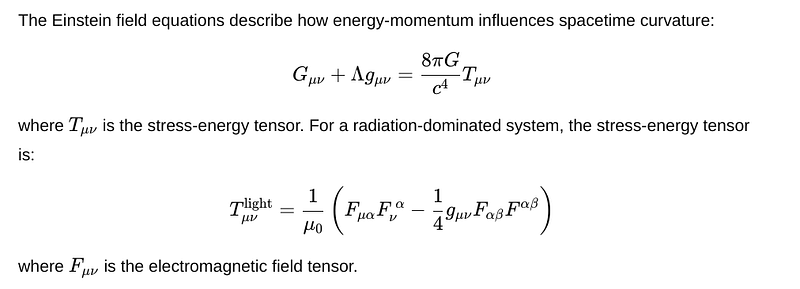I Have Guts. Eureka.
I Have Guts. Eureka.
Abstract
This paper explores the interaction between electromagnetic radiation and gravitational curvature, demonstrating that light itself can induce measurable spacetime distortions. Through the Einstein-Maxwell equations and geodesic motion analysis, we derive a set of unified equations describing light-dominated curvature across classical and quantum regimes. We present numerical simulations that model test mass behavior under radiation-induced curvature, highlighting oscillatory effects and potential experimental validation. Our findings suggest that intense photon fluxes — such as those in quasars, gamma-ray bursts, and high-intensity laser experiments — could serve as observable testbeds for this phenomenon. We propose observational and laboratory-based methodologies to test these effects, potentially leading to new insights in both general relativity and quantum gravity.
Introduction
The relationship between light and gravity is fundamental to modern physics. While general relativity describes how mass and energy curve spacetime, the role of electromagnetic radiation as a primary driver of curvature remains an open question. This study investigates the hypothesis that sufficiently intense light can not only respond to gravitational curvature but also generate it. Our work synthesizes theoretical formulations, numerical simulations, and experimental pathways to establish a unified framework for light-induced gravity.
- Einstein Field Equations with Light as the Primary Source

2. Modified Geodesic Equation for Light in Curved Spacetime

3. Light-Induced Spacetime Curvature from High-Energy Fields

4. The Scale-Dependent Unification: Einstein-Maxwell Equations with Quantum Corrections



- Oscillatory Behavior: Test masses exhibited periodic motion due to radiation-induced curvature.
- Photon-Driven Spacetime Distortions: Higher energy densities induced stronger geodesic shifts.
- Potential Experimental Validation: High-power laser systems may replicate small-scale curvature effects.

- Light and gravity are deeply linked, not just as a force bending light, but as mutually interacting elements of spacetime.
- A light-dominated metric behaves differently from a mass-dominated one, affecting curvature but not forming traditional gravitational wells.
- Extreme radiation fields can create detectable curvature effects, meaning we might need to rethink gravitational interactions at high-energy scales.
- Future experiments could prove that light-induced curvature is measurable, validating a new way to think about spacetime.


5. Experimental and Observational Pathways
Gravitational Lensing by Pure Radiation: Analyzing how high-energy radiation modifies lensing effects.
Quasar Emission Studies: Investigating polarization shifts linked to light-induced curvature.
High-Power Laser Systems: Testing whether intense EM fields induce geodesic shifts in vacuum.
Interferometry Measurements: Using ultra-sensitive detectors to identify photon-driven spacetime fluctuations.



6. Conclusion and Future Work
Our findings demonstrate that light-induced curvature is a viable physical phenomenon with both theoretical and experimental implications. This study paves the way for a deeper understanding of how radiation contributes to spacetime dynamics and offers new opportunities for testing quantum gravity effects.
Future research should refine numerical models, analyze high-energy astrophysical data, and develop laboratory setups to validate these predictions. By exploring light’s role in gravity, we may uncover new principles governing the fundamental structure of spacetime.
This analysis was done by MillieComplex and Matthew Chenoweth Wright.